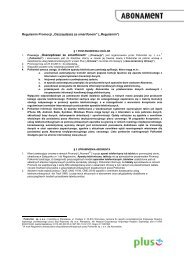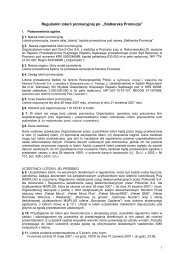Korytarz ekologiczny doliny Odry pdf
Korytarz ekologiczny doliny Odry pdf
Korytarz ekologiczny doliny Odry pdf
Create successful ePaper yourself
Turn your PDF publications into a flip-book with our unique Google optimized e-Paper software.
<strong>Korytarz</strong> <strong>ekologiczny</strong> <strong>doliny</strong> <strong>Odry</strong><br />
dams on parts of the Racibórz Basin and the Wroc³aw Proglacial Stream Valley has an<br />
influence on the existence of the wetlands, as ground inundation has been observed<br />
upstream of those facilities. The largest complex of open peat and swampy terrains is situated<br />
in Miêdzyodrze, in the Lower Oder Valley.<br />
Numerous ox-bows have been preserved in many parts, both between and outside the<br />
levees. They are highly diversified, ranging from small waterholes with an area of several<br />
hundreds sq metres (which often periodically dry up) to reservoirs with an area of many<br />
hectares and up to 8 km long. Most of them are eutrophic waterbodies with many plant<br />
communities and act as important waterfowl areas.<br />
The forests of the Oder valley create a complex of forest associations, conditioned by<br />
hydrological factors typical of large river valleys. The are connected with reservoirs and<br />
stagnating and flowing waters. This complex is composed of deciduous forests covering the<br />
lower terraces of the river, which have significant habitat diversity and a huge variety of<br />
plant and animal life forms. Because natural vegetation has been preserved in many fragments<br />
and the richness of avifauna is observed, these forests can be classified among the<br />
most naturally valuable areas in Europe.<br />
The complex of the Oder’s humid forests covers, on the Polish side, about 18 500 ha of<br />
the Oder valley surface. The area is vast. Inaccessibility of the terrain (periodical floods)<br />
and classification of most forests situated between levees as water- protective forests, have<br />
led to their extensive only management (mostly using the thinning method). For this reason<br />
a great amount of hollowed, fallen and monumental trees have been preserved here, as well<br />
as large areas of old-growth forests.<br />
An especially valuable area is the zone between levees (100 m to over 3 km wide), where<br />
forests are periodically flooded. It is overgrown by the most precious patches of forests (e.g.<br />
lowland willow-poplar floodplain forest Salici-populetum, lowland ashelm floodplain forest<br />
Ficario-Ulmetum campestris oak hornbeam forest), whose value is enhanced by numerous<br />
ox-bows scattered throughout the whole area. In close proximity to the river, the riverine<br />
forests are separated by a network of wet meadows and pastures with groups of trees and<br />
shrubs.<br />
Thanks to the existence of great number of versatile habitats and niches, the deciduous<br />
forests of the Oder valley are inhabited by valuable wildlife populations. It is here, where<br />
the highest densities of breeding birds in Polish forests were found. It is also here, where we<br />
can find one of the largest European populations of Middle-spotted woodpecker (Dendrocopos<br />
medius) with several hundreds of pairs, as well as nesting White-tailed eagle (Haliaetus<br />
albicilla), Red kite (Milvus milvus) – birds included in the European Red List Of<br />
Globally Threatened Species of Plants and Animals. Endemic population of one of the subspecies<br />
of Carabus sp., and numerous populations of Cerambyx Longicorn (Cerambyx<br />
cerdo) – also included in the European Red List....<br />
From among 18 500 ha of deciduous forest in the Oder valley two areas deserve special<br />
attention and protection (possibly in the form of national parks):<br />
• The forests between Malczyce and Œcinawa – the largest complex (about 4000 ha) of<br />
the best preserved humid forests in the Oder valley. Oak and hornbeam forest domi-<br />
212



![PENTAGRAM Cerberus [P 6367] Installation and Operation Manual](https://img.yumpu.com/49786948/1/184x260/pentagram-cerberus-p-6367-installation-and-operation-manual.jpg?quality=85)



![PENTAGRAM Cerberus [P 6361] Quick Guide](https://img.yumpu.com/43449286/1/185x260/pentagram-cerberus-p-6361-quick-guide.jpg?quality=85)








